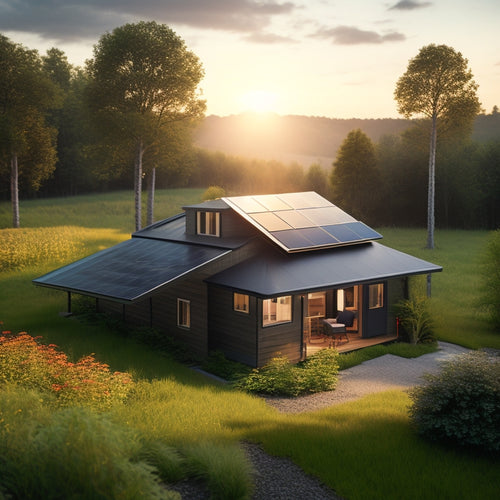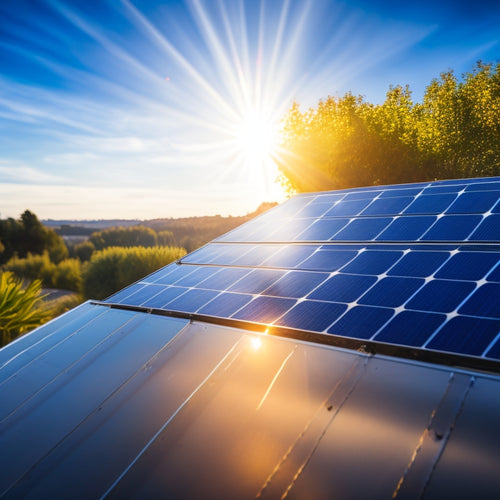
Home Solar and Battery Systems
Share
You can greatly reduce your energy costs and increase your property's value with a home solar and battery system. By understanding your daily energy demands, you can optimize your system's design and energy consumption. With grid connection inverters, you'll have seamless integration with the grid and real-time monitoring capabilities. Plus, your system will provide reliable power during outages and last for 25 years or more with minimal maintenance. As you investigate the benefits of home solar and battery systems, you'll realize how they can support a sustainable energy future and enhance your energy independence - and that's just the beginning of what you'll reveal.
The Essentials
- Home solar and battery systems significantly lower energy costs, with average savings ranging from $500 to $2,100 annually based on system size.
- Installing solar systems enhances home resale value, with solar-powered homes selling for higher prices compared to non-solar homes.
- Understanding daily energy demands is essential for effectively sizing solar and battery systems, ensuring sufficient energy generation and storage capacity.
- Grid connection inverters convert DC power from solar panels to AC power, providing seamless integration with the grid and real-time monitoring capabilities.
- Home solar systems typically last 25 years or more, while battery systems last 10-15 years, offering consistent energy production with minimal maintenance.
Reduce Energy Bills Now
You can markedly lower your energy cost by utilizing the power of solar energy and storing excess energy in a battery system.
By reducing your reliance on the grid, you'll not only save money but also increase your energy independence, which is especially vital during power outages.
With a home battery storage system, you can shave peak demand charges and reduce your overall energy usage during those times of the day when energy rates are at their highest.
This means you'll cut your monthly expenses and enjoy predictable energy bills.
Lower Your Energy Cost
Energy cost reduction is a top priority for homeowners seeking to minimize their environmental footprint and maximize their budget. By investing in a home solar and battery system, you can substantially lower your energy cost and achieve energy independence. With solar incentives, such as the Solar Investment Tax Credit (ITC), you can recoup a significant portion of your investment.
| System Size | Average Energy Savings | Payback Period |
|---|---|---|
| 5 kW | $500 - $700 per year | 5 - 7 years |
| 10 kW | $1,000 - $1,400 per year | 4 - 6 years |
| 15 kW | $1,500 - $2,100 per year | 3 - 5 years |
Cut Monthly Expenses
Frequently, homeowners find themselves struggling to make ends meet due to rising energy bills. You're not alone in this financial burden.
By embracing a cleaner, more sustainable future with Renewable Energy Solutions, you can tackle three major concerns at once. By investing in a home solar and battery system, you can considerably cut your monthly expenses.
With solar incentives, such as federal and state tax credits, you can recoup a substantial portion of your investment. Additionally, you'll benefit from reduced energy bills, as your solar panels generate free electricity during the day.
Increased Property Value
By installing a home solar and battery system, you can greatly increase your home's resale value, making it more attractive to potential buyers.
In fact, studies have shown that solar-powered homes typically sell for higher prices than their non-solar counterparts.
With the increasing adoption of renewable energy, homeowners are becoming more environmentally conscious and willing to invest in eco-friendly features.
Additionally, the sleek, modern design of solar panels and batteries can enhance your property's appeal, setting it apart from neighboring homes.
Boosted Home Resale Value
One of the most notable advantages of installing a home solar and battery system is the substantial increase it gives to your property's resale value.
This enhancement in value comes from the system's ability to provide clean energy, reduce your reliance on the grid, and lower your energy bills. As a homeowner, you'll benefit from solar incentives, such as tax credits and rebates, which can offset the initial cost of installation.
Additionally, the resale potential of your property increases markedly, making it more attractive to potential buyers. According to the National Renewable Energy Laboratory, homes with solar panels sell for up to $15,000 more than similar homes without them.
This increased value can be a major selling point, especially in areas where environmental concerns and energy efficiency are top priorities. By installing a home solar and battery system, you're not only reducing your carbon footprint but also making a smart investment in your property's future.
Enhanced Property Appeal
A home solar and battery system greatly improves your property's appeal, making it stand out in a crowded real estate market. This enhanced appeal is not just about aesthetics; it's also about the value it adds to your property.
| Feature | Benefit |
|---|---|
| Solar Aesthetics | Sleek, modern design that complements your home's design |
| Battery Integration | Seamless integration with your home's electrical system |
| Eco-Friendly Upgrades | Increased property value with environmentally responsible features |
| Landscaping Options | Opportunities to incorporate green spaces and sustainable landscaping |
When considering a home solar and battery system, keep in mind the neighborhood trends and design considerations that will impact your property's appeal. The installation process may require some planning, but the end result is well worth it. With energy independence and financing options available, you can enjoy the benefits of solar power without breaking the bank. Plus, with proper maintenance tips, your system will continue to perform at its best for years to come. By investing in a home solar and battery system, you're not only increasing your property's value but also taking a step towards a more sustainable future.
Grid Connection Inverter Explained
You'll need a grid connection inverter to convert the DC power generated by your solar panels into AC power that's compatible with the grid.
This inverter's conversion process is essential, as it guarantees your system operates safely and efficiently, much like renewable energy systems that rely on grid integration for seamless power distribution.
By leveraging clean energy technology, you can reduce your reliance on public utilities and lower your electricity bills.
You'll also appreciate the system monitoring capabilities that come with these inverters, providing you with real-time data on your energy production and consumption.
Inverter Conversion Process
As we examine the intricacies of home solar and battery systems, it's important to understand the inverter conversion process, an essential component of grid connection inverters. This process involves converting the DC power generated by your solar panels into AC power, which is usable in your home and compatible with the grid.
There are several inverter types, including string inverters, microinverters, and power optimizers, each with their own strengths and weaknesses. During the installation process, your chosen inverter is connected to your solar panel array and configured to optimize energy production.
The inverter conversion process itself involves several stages. First, the DC power from your solar panels is fed into the inverter. The inverter then converts this DC power into AC power, synchronizing it with the grid's frequency and voltage.
Finally, the AC power is fed into your home's electrical panel, where it can power your appliances and devices. Any excess energy is fed back into the grid, and you may even be eligible for credits or rebates from your utility company.
Understanding the inverter conversion process is essential to getting the most out of your home solar and battery system.
System Monitoring Capabilities
Monitoring your home solar and battery system's performance is essential to optimizing its efficiency and identifying potential issues. A grid connection inverter with advanced system monitoring capabilities can provide you with real-time analytics and performance tracking. This allows you to stay on top of your system's operation, making data-driven decisions to maximize energy production and reduce energy waste.
With real-time monitoring, you can track your system's performance in real-time, receiving alerts and notifications when issues arise. This enables you to address problems promptly, minimizing downtime and reducing maintenance costs.
Performance tracking also provides significant observations into your energy usage patterns, helping you identify opportunities to optimize your energy consumption and reduce your reliance on the grid.
Advanced system monitoring capabilities also enable remote monitoring and control, allowing you to access your system's performance data and make adjustments from anywhere, at any time. This level of control and visibility gives you the freedom to optimize your energy usage and reduce your carbon footprint, taking a significant step towards energy independence.
Assess Your Energy Demands
You need to understand your daily energy usage patterns to determine how much energy your solar and battery system must provide. This involves calculating your current energy consumption rate, measured in kilowatt-hours (kWh), to identify areas of high demand.
For instance, households with electric vehicle charging stations may require more power during evening hours when vehicles are charged. By analyzing your energy usage, you can pinpoint the times of day when you need the most power and size your system accordingly.
Daily Energy Usage Patterns
Understanding your daily energy usage patterns is crucial in determining the size and configuration of your home solar and battery system. You need to identify your energy consumption trends to guarantee you're generating and storing enough energy to meet your needs.
Take a closer look at your daily routine to pinpoint peak usage times. Are you a morning person who fires up the coffee maker and turns on the lights as soon as you wake up? Or do you have a family that uses multiple devices simultaneously in the evening? Knowing when you use the most energy will help you design a system that can handle those peak periods.
You should also consider your energy usage habits on weekends and weekdays, as they might differ notably. Are you home during the day on weekends, or are you out and about? Do you have energy-intensive appliances like pool pumps or electric vehicle chargers that consume a lot of power?
Current Energy Consumption Rate
Your daily energy usage patterns provide a solid foundation for evaluating your energy demands.
Now, it's crucial to assess your current energy consumption rate to understand how much energy you need to generate and store. This involves calculating your total daily energy consumption in kilowatt-hours (kWh). You can do this by reviewing your past utility bills or using a smart plug to track your energy usage.
Analyzing your energy consumption trends will help you identify areas where you can improve energy efficiency. For instance, you might realize that your energy usage peaks during the evening hours when you're using lights, TVs, and computers.
This understanding can inform your decision on the size and type of solar panel system and battery storage you need. By comprehending your energy consumption patterns, you can optimize your energy usage and reduce your reliance on the grid.
This, in turn, will enable you to design a home solar and battery system that meets your unique energy demands, giving you the freedom to generate and manage your own energy.
Longer Lifespan Than Generators
You'll find that home solar and battery systems offer a longer lifespan than traditional generators, providing a reliable power source always.
With a typical lifespan of 25 years or more, solar panels and 10-15 years for battery systems, you can count on consistent energy production for years to come.
This means you'll experience fewer interruptions and less maintenance compared to generators, which often require frequent repairs and replacements.
Reliable Power Source Always
Within the domain of backup power solutions, home solar and battery systems stand out for their steadfast reliability, offering a consistent flow of energy when you need it most. You can count on these systems to provide power during outages, natural disasters, or grid failures, ensuring your home remains energized and comfortable.
Unlike traditional generators, solar and battery systems boast a longer lifespan, requiring minimal maintenance and upkeep. This means you'll enjoy uninterrupted energy independence, free from the constraints of the grid.
As you shift to sustainable living, home solar and battery systems become an integral part of your energy strategy. By capturing the sun's energy and storing it in advanced batteries, you'll reduce your reliance on fossil fuels and lower your carbon footprint.
With a reliable power source always at your disposal, you'll have the freedom to live life on your own terms, without worrying about power outages or energy insecurity. By choosing home solar and battery systems, you're investing in a sustainable future, where energy independence is a reality.
Frequently Asked Questions
Can I Install Solar Panels on My Own?
You can attempt a DIY installation, but consider the risks: improper mounting, electrical shock, and voiding warranties. Additionally, you'll be responsible for Solar panel maintenance, which can be time-consuming and require specialized skills.
Are Home Solar Systems Eligible for Government Incentives?
You're likely aware that a family in California saved $15,000 on their solar installation through federal tax credits. Similarly, you can tap into government incentives, such as state rebates and financial incentives, to offset solar financing costs.
How Do I Monitor My Solar Panel's Performance?
You'll want to utilize performance tracking and monitoring tools to guarantee your solar panel's efficiency. You can use data loggers, IoT sensors, or online platforms to monitor energy output, identifying areas for optimization and maximizing your renewable energy freedom.
Can I Use Solar Power During a Grid Outage?
When the grid goes down, you can still utilize solar power if you've invested in a solar battery, granting you grid independence; this setup allows you to store excess energy for later use, keeping you powered during outages.
Do Solar Panels Work Well in Shaded Areas?
You'll find that solar panels' efficiency suffers in shaded areas, as even partial shading can considerably reduce energy output; however, advancements in solar technology have improved performance, and you can still generate some power, albeit at a lower rate.
Final Thoughts
As you flip the switch on your home solar and battery system, you're utilizing the power of the sun like a 21st-century alchemist, turning sunlight into savings. With energy bills dwindling, property value soaring, and a grid connection inverter humming in harmony, you've got a recipe for a sustainable future. By evaluating your energy demands, you've optimized your system for maximum efficiency. And with a lifespan that leaves generators in the dust, you can bask in the glow of a wise investment for years to come.
Related Posts
-

Top Eco-Friendly Camping Equipment for a Sustainable Adventure
When you're camping with the planet in mind, opt for eco-friendly gear like tents made from recycled materials and bi...
-

Diy Off Grid Solar
By embracing DIY off-grid solar, you can break free from grid dependence, slashing your energy bills by up to 90% and...
-

How Efficient Are Thin Film Solar Cells
Thin film solar cells provide an innovative approach to energy generation, boasting efficiency rates generally betwee...


